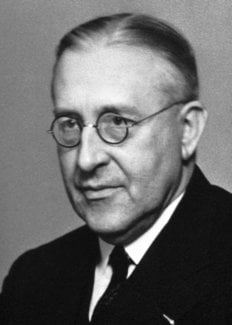Victor F. Hess
Biographical

Victor Franz Hess was born on the 24th of June, 1883, in Waldstein Castle, near Peggau in Steiermark, Austria. His father, Vinzens Hess, was a forester in Prince Öttingen-Wallerstein’s service and his mother was Serafine Edle von Grossbauer-Waldstätt.
He received his entire education in Graz: Gymnasium (1893-1901), and afterwards Graz University (1901-1905), where he took his doctor’s degree in 1910.
He worked, for a short time, at the Physical Institute in Vienna, where Professor von Schweidler initiated him in recent discoveries in the field of radioactivity. During 1910-1920 he was Assistant under Stephan Meyer at the Institute of Radium Research of the Viennese Academy of Sciences. In 1919 he received the Lieben Prize for his discovery of the”ultra-radiation” (cosmic radiation), and the year after became Extraordinary Professor of Experimental Physics at the Graz University.
From 1921 to 1923, Hess was granted leave of absence, and worked in the United States, where he took a post as Director of the Research Laboratory (created by him) of the U.S. Radium Corporation, at Orange (New Jersey), and as Consulting Physicist for the U.S. Department of the Interior (Bureau of Mines), Washington D.C.
In 1923 he returned to Graz University and in 1925 he was appointed Ordinary Professor of Experimental Physics. In 1931 came his appointment as Professor at Innsbruck University and Director of the newly established Institute of Radiology. He founded the station at the Hafelekar mountain (2,300 m) near Innsbruck for observing and studying cosmic rays.
As well as the Nobel Prize for 1936, which he shared with C.D. Anderson, Hess has been awarded the Abbe Memorial Prize and the Abbe Medal of the Carl Zeiss Institute in Jena (1932); he was also Corresponding Member of the Academy of Sciences in Vienna.
Hess’s work which gained him the Nobel Prize, was carried out during the years 1911-1913, and published in the Proceedings of the Viennese Academy of Sciences. In addition he has published some sixty papers and several books, of which the most important were: “Die Wärmeproduktion des Radiums” (The heat production of radium), 1912; “Konvektionserscheinungen in ionisierten Gasen-Ionenwind” (Convection phenomena in ionized gas-ionwinds), 1919-1920; “The measurement of gamma rays”, 1916 (with R.W. Lawson); “The counting of alpha particles emitted from radium”, 1918 (also with R. W. Lawson); Elektrische Leitfähigkeit der Atmosphäre und ihre Ursachen (book), 1926 (in English: The Electrical Conductivity of the Atmosphere and Its Causes, 1928); Ionenbilanz der Atmosphäre (The ionization balance of the atmosphere – book), 1933; Luftelektrizität (Electricity of the air – book, with H. Benndorf), 1928; “Lebensdauer der Ionen in der Atmosphäre” (Average life of the ions in the atmosphere), 1927-1928; “Schwankungen der Intensität in den kosmischen Strahlen” (Intensity fluctuations in cosmic rays), 1929-1936.
Hess has been American citizen since 1944, and is living in New York.
This autobiography/biography was written at the time of the award and first published in the book series Les Prix Nobel. It was later edited and republished in Nobel Lectures. To cite this document, always state the source as shown above.
Victor F. Hess died on December 17, 1964.
Nobel Prizes and laureates
Six prizes were awarded for achievements that have conferred the greatest benefit to humankind. The 14 laureates' work and discoveries range from quantum tunnelling to promoting democratic rights.
See them all presented here.
